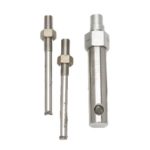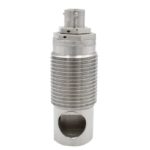Pyro Cutters
Product Description
A pyro cutter uses energetic materials and a cutting blade to sever objects. It is a cartridge actuated device which, when initiated, will sever/cut a multitude of materials and cross-sectional shapes. Common targets used with ordnance cutting devices include: steel, electrical or fiber optic cables, aluminum, titanium, copper, Kevlar, vectran, zylon, bolts, tubes and woven fiber cords/lines and straps.
To learn more about various types of cutters, visit the pages below:
Key Features
- They allow the separation structures to be connected by ordinary bolts, not requiring weakening treatment
- Their bearing capacity is high
- They achieve unlocking by cutting the bolt from the middle
- Their performance is not affected by the installation conditions, such as the bolt preload force
- After the cutting work is completed, the gas is completely sealed in the chamber and no undesired products are generated
The key factors for the cutter are the design of the cutter blade and the control of the cutting capacity to ensure that the bolts can be completely cut.
The design of a pyrotechnic cutter is an actuating component of a hold-down and release device, and it consists of an igniter, a casing, a detonator, a shear pin, a sealing ring, a cutter, a cutting board, and an end cover.
Applications
There are basically two types of cutters, guillotine and punch. A guillotine cutter uses a blade knife which is propelled internally by an energetic material which hits an anvil to stop the blade and sever the material. They are used where there is a need for rapid, remote cutting of cable, wire rope, hoses or fuel lines.
A cartridge actuated cutter has a sealed-in cartridge. Consisting of a tubular body containing a spring-loaded firing pin and it may include a timing delayed cartridge for initiation. Once the cartridge is fired, the expanding gases produced force the cutter blade forward, severing the target material.
How a cutter works:
- A charge is detonated by an electric detonator
- A large amount of high-temperature and high-pressure gas is generated to initiate the cutter blade motion
- After moving for a certain distance, the cutter blade reaches a certain speed and gains considerable kinetic energy,
- Resulting in its collision and penetration with the target material, thereby fracturing the target material.
- Once the target material is fractured, this instantly releases the constraint of the pre-tightening force and unlocks any connecting material









